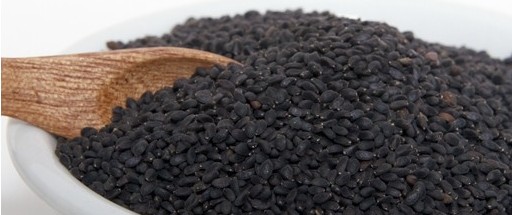


Tukmaria seeds (ocimun basilicum) are sacred in many Asian countries, due to their excellent nutritional properties. They are an ingredient used in Ayurvedic medicine in India, but also in Southeast Asian dishes, including desserts and drinks. Other popular names are falooda and basil seeds.
Although tukmaria has been part of a balanced diet in many countries for ages, it is almost unknown in many western countries. In part due to the success of their "cousin" chia seeds, they are now being discovered and gaining popularity in Europe and America.
Tukmaria seeds are very small (similar to poppy seeds), black and have a neutral flavor.
Tukmaria seeds are very nutritious and low in calories (233 Kcal per 100g) compared with "their cousin” chia seeds (which have 595 Kcal per 100g). They have antioxidant properties and are a good food for coeliacs.
Tukmaria seeds are rich in protein (23g per 100g), calcium (2240 mg - 224% of the recommended daily dose: RDD), iron (89mg - 499% of RDD), magnesium (711mg - 178% of RDD), potassium (2630mg - 56%), vitamin E (10.7mg - 53% of RDD) and folic acid (310 mcg - 78% of RDD).
Numerous benefits have been attributed to tukmaria seeds, when consumed regularly as part of a balanced diet. Among the numerous effects, those can be highlighted:
The mucilaginous gel that forms around the seeds when they are soaked acts as an emollient, which soothes mucous membranes.
The seeds can act as an appetite suppressant during weight loss programs, when eaten (or drunk) before meals. Since they are very nutritious and poor in calories, they contribute to minimise the possibility of nutritional deficiency even under low calories intake.
Like chia seeds, which also form a gel when soaked, it is believed that tukmaria seeds slow down the body process of converting carbohydrates into sugars, also contributing to weight loss and appetite. That accounts for the feeling of fullness lasting longer and can be useful for both weight loss and diabetes.
Regular consumption of these seeds contributes to an improvement in the digestive tract, removing toxins from the gut.
They also help preventing heart conditions by lowering cholesterol levels.
For all the benefits presented, tukmaria seeds are an excellent addition to a balanced diet.
 Tukmaria seeds are a very versatile food. They can be used in many recipes, drinks, desserts and even in cakes as a binding agent (for example, to replace eggs). To consume the seeds just mix them in muesli, yogurts, salads, smoothies, soup, pasta dishes or in making cookies, bread or crackers.
Tukmaria seeds are a very versatile food. They can be used in many recipes, drinks, desserts and even in cakes as a binding agent (for example, to replace eggs). To consume the seeds just mix them in muesli, yogurts, salads, smoothies, soup, pasta dishes or in making cookies, bread or crackers.
You can also mix a tablespoon of seeds in 250 ml of water (they increase volume several times), let stand about 15 minutes and drink plain, mixed with lemon juice or fruit smoothies. They can also be used to thicken beverages and desserts.
Insert date: 2013-07-30 Last update: 2013-07-31
Comment
![]()
![]()
Authors > Contributor writers > Cristina Rodrigues
Cereals and Seeds
Authors > Translators > Carolina Freitas